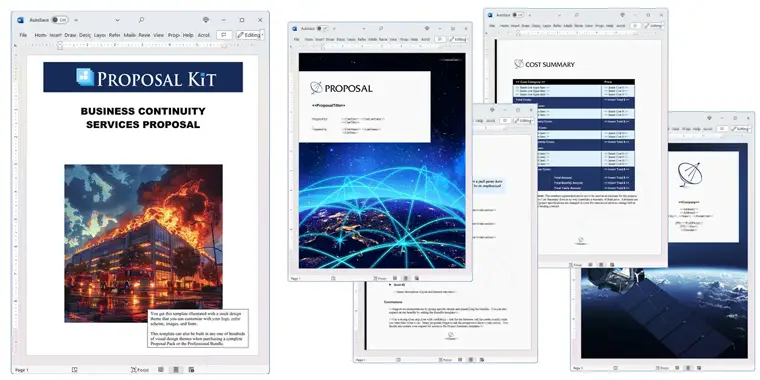How to write your Business Continuity Services Proposal
We include this 15 page layout with every Proposal Pack. If you want this template to have a different visual design theme than the one illustrated here, purchase any Proposal Pack design and create this template using the purchased design theme. This template is included in every Proposal Pack. If you get a Proposal Pack or the Professional, you can also make any variation of this template with different chapters to suit your needs.
We typically include more chapters in the templates than most people will need to give everyone more variety in the chapters they may need. You can trim down a long template by removing pages you do not need or combining multiple chapter topics into one page.
 DOWNLOADABLE, ONE-TIME COST, NO SUBSCRIPTION FEES
DOWNLOADABLE, ONE-TIME COST, NO SUBSCRIPTION FEES![]() View Business Continuity Services Sample Proposal
View Business Continuity Services Sample Proposal
This sample proposal is based on the same layout as this template and is included in every Proposal Pack. The visual design of the templates will match whichever Proposal Pack design you purchase. To get this template in a different design theme than shown in the sample, purchase any other Proposal Pack design theme and this template will be included.
You can create an editable Word version of this sample in any design theme of your choice including branded to your logo.
You can also create countless variations of this document to suit your needs using the included library of 2200+ chapters if ordering a Proposal Pack or Professional.
 What Our Clients Say
What Our Clients SayAside from the great number of templates and modifiable pages (depending on which pack you purchase), the Wizard allows a tremendous amount of time savings in gathering all the templates together. An example would be including a Cover letter, Estimate, Non-Disclosure, Statement of Work and Contract and Terms. The Wizard is capable of pulling all these templates together into one document with the same proposal, contract or project theme."
President and CEO KithTECH
Related Article
Related Video
Related Templates
- Succession Planning Proposal
- IT Disaster Recovery Services Proposal
- Disaster Relief and Recovery Proposal
- Disaster Preparation and Training Proposal
- Business Plan to Restart Shuttered Business
- Company Operations Manual
- Emergency Preparation Project Proposal
- Reputation Management Services Proposal
- Business Model Change Planning Rolling Shutdowns Proposal
- Stockpiling Emergency Supplies Proposal
- Life Insurance Coverage Proposal
- Insurance Coverage Services Proposal
- Insurance Quotation Proposal
Mastering Business Continuity Services Proposals with Proposal Kit
Preparing for the unexpected is not just wise, it's essential. This is where the concept of business continuity and disaster recovery comes into play. Writing a compelling proposal for these services can be daunting, especially for those unfamiliar with the process. Fortunately, Proposal Kit offers a streamlined solution.
Imagine your business facing an unforeseen disaster. Do you have a plan to ensure continued operations and data protection?
The Best Way to Write a Business Continuity Services Proposal
For beginners, the ideal approach involves:
- Understanding the Client's Needs: Identify the specific business continuity and disaster recovery needs of the client.
- Utilizing Proposal Kit Templates: Access a diverse range of templates designed for business continuity proposals.
- Employing Wizard Software: This tool guides you step-by-step, ensuring all crucial aspects of the proposal are addressed.
- Incorporating Financial Details: Use the line item quoting database for accurate financial planning, including costs summaries and budgets.
What Types of Projects Are Business Continuity Services Proposals Written For?
- Developing and implementing disaster recovery plans.
- Creating data backup and protection strategies.
- Establishing emergency response procedures.
- Designing IT infrastructure redundancy plans.
- Conducting business impact analyses.
- Planning for supply chain disruption.
- Setting up remote work solutions.
- Organizing crisis communication plans.
- Training employees on disaster response.
- Testing and maintaining continuity plans.
Chapters this template is built with
There are thousands of chapter templates available in the Proposal Kit template library to add to your custom proposal. Some key templates that can be used in this type of proposal include the following.
Each of these topics is crucial in creating a thorough and convincing business continuity services proposal. They collectively provide a clear and structured approach to demonstrating how your services can protect and sustain a business through unforeseen challenges and disruptions. This is just a fraction of the templates available in Proposal Kit's extensive library, allowing customization to suit any proposal's needs.
Executive Summary
The Executive Summary serves as the proposal's opening statement, offering a concise but comprehensive overview. It should encapsulate the main points of the proposal, including the purpose, scope, and major components of the business continuity plan. This section is critical as it sets the tone and provides a snapshot of the proposal to capture the reader's interest and convey the proposal's value proposition.
Risk Assessment
Risk Assessment is a vital component that involves identifying potential risks that could disrupt business operations. This includes natural disasters, cyber-attacks, system failures, and other unforeseen events. Each risk is evaluated in terms of its likelihood and potential impact on the business. This assessment forms the basis for the development of effective strategies to mitigate these risks.
Recovery Strategy
The Recovery Strategy outlines the approach and methods to be used to restore business operations following a disaster. This includes detailed plans for data recovery, resuming critical functions, and ensuring continuity of services. The strategy should be tailored to address the specific risks identified in the Risk Assessment and must be realistic and achievable.
Implementation Plan
This section details the specific steps required to implement the proposed business continuity measures. It includes timelines, resource allocation, responsibilities, and any necessary training for staff. The Implementation Plan should be clear and sequential, ensuring that all stakeholders understand their roles and the expectations for executing the plan.
Cost Summary
The Cost Summary provides a comprehensive financial breakdown of the proposed solutions. This should include the costs associated with implementing the continuity measures, such as technology investments, training, resource allocation, and any ongoing maintenance costs. Providing a clear cost summary helps in justifying the investment in business continuity planning and assists decision-makers in understanding the financial implications.
Threats
Under Threats, the proposal should detail specific challenges that could pose a risk to business operations. This section goes beyond general risk assessment to delve into particular scenarios and threats relevant to the business's industry or geographical location. Understanding these threats helps in tailoring the business continuity plan to be more effective.
Disaster Recovery Plan
This part of the proposal focuses specifically on strategies and procedures for recovering from a disaster. It should include detailed plans for data and system backups, restoration processes, and alternative operating procedures in the event of different types of disasters.
Preparedness
Preparedness involves the measures taken in advance to ensure effective response to a disaster. This includes training employees, establishing communication protocols, and pre-arranging resources and support. A well-prepared organization can significantly reduce the impact of a disaster.
Continuity
Continuity is the overarching goal of the proposal. This section should describe how the proposed measures will ensure uninterrupted business operations, or at least a swift return to normalcy, in the face of disruptions. It focuses on maintaining critical functions and minimizing downtime during and after a disaster.
Recommendations
In Recommendations, provide expert suggestions based on the assessment and analysis conducted. This includes recommended strategies, technologies, and practices that the business should adopt to enhance its resilience. Tailoring these recommendations to the specific needs and context of the business is crucial for their effectiveness.
Services Provided
Finally, the Services Provided section should detail the specific services your company offers related to business continuity and disaster recovery. This could include consultancy, implementation of continuity plans, training programs, support and maintenance services, and any additional assistance you offer to help businesses prepare for and recover from disasters.
Use cases for this template
Alex's IT Business Continuity Pitch
Alex, leading a small IT firm, recognized the critical need for robust business continuity services among his clients, especially in an era where data breaches and system failures are increasingly common. He needed to convince his clients that his services were not just beneficial but essential for their operational integrity.
Using Proposal Kit, Alex developed a proposal that was both comprehensive and client-specific. He began with a detailed risk assessment, identifying potential threats unique to each client's industry and operations. His proposal outlined a range of tailored solutions, from advanced cloud backup systems to sophisticated redundant network setups, ensuring minimal downtime in case of system failures.
What made Alex's proposal stand out was its emphasis on customization. For each client, he proposed a unique set of solutions, demonstrating his understanding of their specific IT infrastructures and business needs. He also included case studies of successful implementations, reinforcing the effectiveness of his strategies. The clear, concise, and professional format of the proposal, facilitated by Proposal Kit, helped Alex in not only securing new contracts but also establishing long-term trust with his clients.
Taylor's Corporate Continuity Plan
In a large, multi-departmental corporate setting, Taylor faced the daunting task of creating a business continuity plan that catered to diverse operational facets. The challenge was to develop a comprehensive plan that was both feasible and effective across the corporation's broad spectrum of functions.
Using the structured approach of Proposal Kit, Taylor wrote a proposal that began with a thorough risk assessment, evaluating potential threats ranging from cyber-attacks to natural disasters. He then outlined a series of tailored recovery strategies, ensuring each department's critical operations could be quickly restored post-disaster.
Taylor's proposal also emphasized employee readiness, proposing extensive training programs and drills to prepare staff for various emergency scenarios. This aspect demonstrated a deep understanding of the human element in business continuity.
The well-organized and detailed nature of the proposal, achieved through Proposal Kit, was instrumental in its prompt approval by corporate management. It not only met the urgent deadline but also provided a robust, actionable plan that enhanced the corporation's overall disaster resilience.
Morgan's Non-Profit RFP for Continuity Services
Morgan's task was to draft an RFP that would attract competent service providers capable of equipping her non-profit organization with effective business continuity strategies. The organization operated globally, often in regions prone to political, environmental, or health-related disruptions, making operational continuity a complex challenge.
Leveraging Proposal Kit, Morgan was able to articulate the non-profit's specific needs and desired outcomes in the RFP. She included detailed requirements for data protection, emergency response mechanisms, and continuity solutions that could be adapted to various global regions where the organization operated.
What made Morgan's RFP compelling was its clarity in outlining the scope of services needed, coupled with the flexibility for potential service providers to propose innovative solutions. Her emphasis on adaptability and scalability in the RFP catered to the dynamic nature of the non-profit's operations.
The professional and comprehensive RFP generated responses from a range of qualified service providers, demonstrating the effectiveness of Proposal Kit in creating documents that effectively communicate an organization's needs while attracting appropriate responses.
In each situation, the use of Proposal Kit was central to success. Alex, Taylor, and Morgan, each facing different challenges and operating in different environments, found a common solution in Proposal Kit. Its ability to streamline the proposal and RFP development process, while ensuring clarity, professionalism, and specificity, makes it an invaluable tool for business continuity planning.
Conclusions and Recommendations
From Alex's successful client pitches in the IT industry to Taylor's corporate proposal and Morgan's non-profit RFP, these situations exemplify the adaptability and efficiency of Proposal Kit. Whether it's for a small business, a large corporation, or a non-profit organization, Proposal Kit provides the tools and guidance necessary to create compelling business continuity services proposals. It simplifies the proposal-writing process, making it accessible even to those new to the task, while ensuring the final document is comprehensive, professional, and tailored to specific needs. In the ever-important field of business continuity, Proposal Kit stands as a valuable ally, helping to prepare businesses for the unexpected and ensuring their resilience in the face of adversity.
Also Known As
This template may also be referred to in different ways or be used in more specialized situations, such as:
- Business Continuity Management Proposal
- Organizational Resilience Plan Proposal
- Disaster Recovery Planning Proposal
- Operational Continuity Strategy Proposal
- Business Resumption Plan Proposal
- Crisis Management Plan Proposal
- Business Continuity Planning (BCP) Proposal
- Emergency Response and Recovery Proposal
- Enterprise Continuity Management Proposal
- Risk Mitigation and Business Continuity Proposal
Abstract
 Ensuring the resilience of a business in the face of unexpected disruptions is crucial for maintaining operations and safeguarding important functions. Business continuity planning involves a meticulous process that focuses on developing effective strategies to minimize downtime and financial loss. By creating comprehensive business continuity plans (BCP), organizations can protect critical business functions and maintain customer satisfaction even during crises. A well-structured proposal outlines the planning process, detailing how each department and business unit can address potential disruptions, from human error to natural disasters, ensuring continuity and minimizing revenue loss.
Ensuring the resilience of a business in the face of unexpected disruptions is crucial for maintaining operations and safeguarding important functions. Business continuity planning involves a meticulous process that focuses on developing effective strategies to minimize downtime and financial loss. By creating comprehensive business continuity plans (BCP), organizations can protect critical business functions and maintain customer satisfaction even during crises. A well-structured proposal outlines the planning process, detailing how each department and business unit can address potential disruptions, from human error to natural disasters, ensuring continuity and minimizing revenue loss.
Effective business continuity planning requires collaboration among business leaders, key personnel, and business partners. The business continuity team plays an integral role in conducting risk assessments and developing action plans to address possible situations. This includes establishing backup sites and data backups to safeguard important data and minimize data loss. Business continuity plans should also incorporate emergency management procedures and involve training for emergency responders and employees to ensure a coordinated initial response.
Organizations must consider both the recovery time objective and recovery point objective to achieve a swift recovery of internal systems and other operations. Implementing robust risk management strategies and maintaining open communication channels with key suppliers and partners help sustain the supply chains and prevent disruption. Regular updates and testing, such as tabletop exercises, ensure the continuity plan remains relevant and effective.
 The company's reputation and brand can be significantly affected by how well it manages business disruptions. Therefore, business continuity planning is not limited to large corporations; small businesses also benefit from having a plan in place to continue operating during emergencies. A detailed business continuity services proposal should include cost summaries and outline the resources needed to carry out the plan objectives. Senior management should lead the planning efforts, ensuring compliance with regulations and overseeing the implementation of strategies designed to protect business assets and relationships with customers and vendors.
The company's reputation and brand can be significantly affected by how well it manages business disruptions. Therefore, business continuity planning is not limited to large corporations; small businesses also benefit from having a plan in place to continue operating during emergencies. A detailed business continuity services proposal should include cost summaries and outline the resources needed to carry out the plan objectives. Senior management should lead the planning efforts, ensuring compliance with regulations and overseeing the implementation of strategies designed to protect business assets and relationships with customers and vendors.
Business continuity planning is a proactive approach that helps organizations realize the importance of preparing for emergencies. By addressing business continuity issues and establishing roles and responsibilities, companies can confidently navigate crises and maintain a good reputation. Proposal Kit provides valuable tools and templates to aid in the creation of a comprehensive business continuity plan tailored to an organization's specific needs and industry standards, thereby enhancing their resilience and ability to respond to any disruption.
A comprehensive business continuity planning process is important for organizations to respond to possible disruptions and maintain business operations. This process involves identifying critical business functions and prioritizing them to ensure that operations continue seamlessly, even during emergencies. A well-prepared business continuity plan (BCP) serves as a roadmap for organizations to operate and minimize revenue loss while also ensuring customer satisfaction and preserving the company's reputation.
 The business continuity team, comprising key players and senior management, is responsible for conducting thorough risk assessments to identify potential threats that could negatively impact the organization. These threats might include natural disasters, technological failures, or cyber-attacks. By understanding these risks, the team can develop strategies that address the recovery point objective and recovery time objective, ensuring swift restoration of important functions and minimizing downtime.
The business continuity team, comprising key players and senior management, is responsible for conducting thorough risk assessments to identify potential threats that could negatively impact the organization. These threats might include natural disasters, technological failures, or cyber-attacks. By understanding these risks, the team can develop strategies that address the recovery point objective and recovery time objective, ensuring swift restoration of important functions and minimizing downtime.
A business continuity planning suite provides the necessary tools to create effective action plans, allowing organizations to deal with various possible situations. This includes the establishment of alternate facilities and backup sites to safeguard sensitive data and important business information. Regular testing and updates, such as conducting tabletop exercises, help verify the effectiveness of the continuity strategies and ensure ongoing preparedness.
To maintain workforce continuity, organizations must engage in crisis management and emergency response planning. This involves training employees and emergency responders, establishing clear communication protocols, and ensuring adequate supplies are available. The involvement of human resources is crucial in coordinating these efforts and ensuring that employees are informed and confident in their roles.
 Involving business partners and key suppliers in the continuity planning process is vital to maintaining supply chains and minimizing disruption to production lines. By fostering strong relationships with external vendors and consulting experts, organizations can enhance their resilience and adapt to changing market demands.
Involving business partners and key suppliers in the continuity planning process is vital to maintaining supply chains and minimizing disruption to production lines. By fostering strong relationships with external vendors and consulting experts, organizations can enhance their resilience and adapt to changing market demands.
Regular reviews of the continuity plan, performed on an ongoing basis, ensure compliance with legal and regulatory requirements and address any weaknesses identified during drills or actual incidents. By continuously adapting the plan to the business environment, organizations can stay ahead of potential crises and safeguard their assets.
Ultimately, business continuity planning is not just about responding to crises but also about realizing the importance of proactive risk management. By ensuring that all departments and business units are prepared for emergencies, companies can confidently lead their industries, maintain their brand integrity, and achieve long-term success even in the face of adversity. Proposal Kit offers a structured approach to creating business continuity services proposals that are both comprehensive and tailored to specific organizational needs, helping businesses prepare for the unexpected and emerge resilient.
Frequently Asked Questions
What should I include in a business continuity services proposal?
A comprehensive business continuity services proposal should include several key components: an executive summary, a detailed assessment of potential risks and vulnerabilities, a continuity strategy outlining how the business will maintain operations during disruptions, roles, and responsibilities for team members, communication plans, recovery procedures, and a plan for regular testing and updates. Including these components ensures the proposal is thorough and provides a clear roadmap for maintaining business operations during unforeseen events.
How do I assess the risks and vulnerabilities specific to my business?
Assessing risks and vulnerabilities involves conducting a thorough risk assessment and business impact analysis (BIA). Start by identifying potential threats that could disrupt your business, such as natural disasters, cyber-attacks, or supply chain failures. Evaluate the likelihood and potential impact of each threat. The BIA helps determine which business functions are critical and their potential disruption consequences. This information will guide the development of your continuity strategies and prioritize actions based on their impact on operations.
How do I ensure my proposal is tailored to my company's needs?
To tailor your proposal to your company's needs, engage with various departments and stakeholders to understand their unique challenges and requirements. Gather input through meetings, surveys, and interviews to identify critical functions, resources, and interdependencies. Customize the continuity strategies to address these needs and consider the company's size, industry, location, and regulatory requirements. The proposal will be more relevant and actionable by involving key stakeholders and addressing their concerns.
What are the best practices for ensuring effective communication during a disruption?
Effective communication during a disruption is critical for maintaining operations and ensuring the safety of employees. Best practices include establishing clear communication protocols, designating a crisis communication team, and using multiple communication channels such as emails, phone calls, text messages, and social media. Ensure that contact information for all employees, stakeholders, and emergency services is up-to-date and accessible. Regularly test communication plans through drills and simulations to identify and address any gaps.
How often should I review and update the business continuity plan outlined in my proposal?
The business continuity plan should be reviewed and updated at least annually or whenever significant changes occur in the business, such as new operations, technologies, or personnel changes. Regular reviews ensure the plan remains relevant and effective. Additionally, conducting regular tests and drills can help identify areas for improvement and ensure that employees are familiar with their roles and responsibilities. Staying current with industry best practices and regulatory requirements also necessitates periodic updates to the plan.
20% Off Discount
![]() Add To Cart This Word Template
Add To Cart This Word Template
 Add To Cart Proposal Pack Telecom #4
Add To Cart Proposal Pack Telecom #4
 Add To Cart Proposal Kit Professional
Add To Cart Proposal Kit Professional
 4.7 stars, based on 849 reviews
4.7 stars, based on 849 reviewsProposal Kit chapters used in this template
Cover Letter, Title Page, Table of Contents, Executive Summary, Threats, Services Provided, Disaster Recovery Plan, Preparedness, Continuity, Logistics, Cost Summary, Recommendations, Company History, References, Back Page
Line Item Automated Chapters
If you purchase a Proposal Pack or the Professional Bundle, these proposal pages are generated using an automated line-item database in the included Wizard software.
Cost Summary
You use this proposal for
- General business proposal
- Technical proposal
- Service sales proposal
- Project pitch proposal
- Security, safety, protection, investigation proposal
How to create this template with Proposal Pack Wizard
You can create this document using any of the logo-designed Proposal Packs. Pick any Proposal Pack with a logo design theme you like best; they will all work equally well. The Proposal Pack for Any Business is the pack with no extra added logos or colors - designed to be used plain or for you to customize with your logos and graphics.
The Proposal Pack design theme you purchase will determine the visual look of this template. The screenshot above only shows the plain generic design theme.
We include a library of chapters to be assembled based on your needs. All proposals are different and have different needs and goals. We designed Proposal Pack so you can customize the documents to suit your needs.
You will best create this document using the Proposal Pack Wizard - Expert Edition software to select this template and build it in the Proposal Pack logo design theme of your choice along with any desired customizations (such as adding additional chapters, removing unneeded chapters, changing the order of chapters, and importing your company logo). This template outlines a proposal for the described situation. Each user is responsible for typing in the actual content of the provided pages with their information to complete the proposal. Suggestions in the abstract may include features in higher-end packages and are facilitated by the selection of chapter templates to support the narrative of each proposal, which help guide the user in filling in the details.
The Wizard software's AI Writer will write the content of the pages of the template based on details provided for your company, client, project, financial details and other writing instructions. This will provide a personalized version of the template completely written and ready to edit.
Once finished, the AI Writer's Word-to-PowerPoint converter can transform your proposal, business plan, or other business documents into a PowerPoint slideshow. Save time and effort by letting the AI analyze every chapter to condense its content into talking points, visually matching the document, and providing a consistent package of presentation material with the click of a button.
You create this template using the Wizard software with an entire Proposal Pack library and software. We include the Expert Edition of the software in the Proposal Kit Professional. Microsoft Word for Windows is required to use the customizing software. You can also edit Word document templates in other office software such as Word for Mac. We will assist Mac users in assembling complex templates for their first project if they do not have the required platform to run the Wizard software.
How to Build Templates Featured on Proposal Kit Website
Many people find the Proposal Kit website after searching for a specific proposal. Once you've purchased and installed the software, how do you build that template you found in the first place? This video shows you how to build any proposal you see on the Proposal Kit website.
 Ian Lauder has been helping businesses write their proposals and contracts for two decades. Ian is the owner and founder of Proposal Kit, one of the original sources of business proposal and contract software products started in 1997.
Ian Lauder has been helping businesses write their proposals and contracts for two decades. Ian is the owner and founder of Proposal Kit, one of the original sources of business proposal and contract software products started in 1997.By Ian Lauder
 Published by Proposal Kit, Inc.
Published by Proposal Kit, Inc.


 Cart
Cart
 Get 20% off ordering today:
Get 20% off ordering today: 


 Facebook
Facebook YouTube
YouTube Bluesky
Bluesky Search Site
Search Site